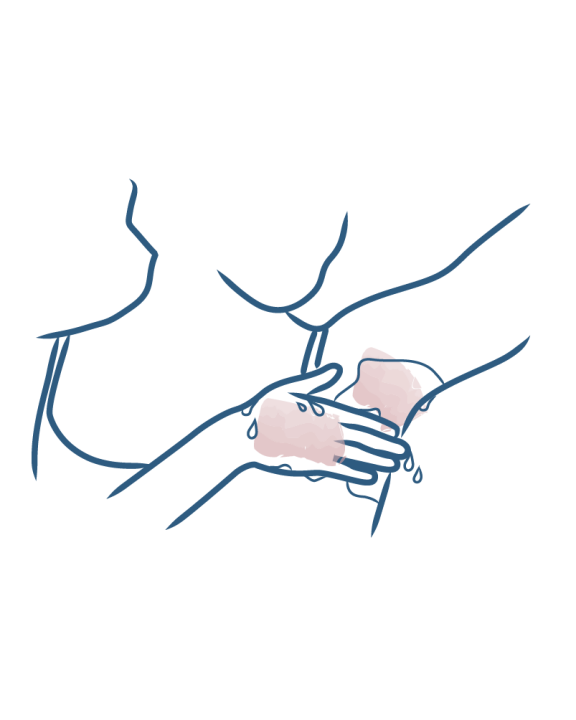Symptoms of excessive perspiration
- How to treat hyperhidrosis?
- Botulinum toxin injections for preventing hyperhidrosis
- Antiperspirant active ingredients for preventing hyperhidrosis
- Anticholinergic medication for preventing hyperhidrosis
- Surgery for preventing hyperhidrosis
- Iontophoresis for preventing excessive perspiration
- Aluminium salts
- Managing stress and emotions

Symptoms of excessive perspiration
Hyperhidrosis is a term used to describe excessive production of sweat. In other words, when the amount of sweat produced exceeds that necessary for the thermoregulation of our body. It is often a taboo subject, one we do not always dare to discuss with our doctor. However, there are ways of controlling sweat production and of reducing the effects of excessive perspiration on our daily lives.
Sweat: our body’s thermostat
Sweating is a totally natural and essential phenomenon for our body. It cools it down when its temperature increases, for example during physical activity or in hot weather. The gland that acts as the control centre for our body temperature is located in our brain, and it’s called the hypothalamus. Its role is to maintain the body at 37 °C, and it will react to any increase in temperature by increasing the production of sweat.
Sweat is produced by sweat glands, of which there are about 4 million distributed over our skin surface. They release on average 1 liter of sweat per day. Sweat production is increased in people suffering from hyperhidrosis.
Different types of hyperhidrosis
Primary hyperhidrosis
The vast majority of people suffer from primary hyperhidrosis, i.e. there is no identifiable cause. It usually appears in childhood or adolescence. It is most often characterized by symptoms of excessive perspiration that appear in the morning or during the day.
Secondary hyperhidrosis
“Secondary” hyperhidrosis is the consequence of a disease, an illness or of taking medicinal treatments. Therefore, if you suddenly experience symptoms of oversweating, and if hyperhidrosis has never been a problem before, there is a high probability that it has been brought on by another disease. That’s why it’s important to see your doctor as soon as symptoms begin to appear in order to determine the cause.
Localized or generalized hyperhidrosis
In 90%(1) of cases, hyperhidrosis is localized and bilateral. The phenomenon of excessive perspiration then affects only certain areas of the body. So you might experience facial sweating, oversweating of the feet, palmar hyperhidrosis or excessive perspiration of the hands, hyperhidrosis of the armpits, or even sweating on the back, head or more rarely the legs.
Hyperhidrosis can also be more widespread and affect the entire body.
Night sweats
Night sweats are a phenomenon of sweating that occurs at night, sometimes causing you to suddenly wake up. It’s a very common phenomenon when stressed or anxious, and in case of nightmares or restless sleep.
If it happens often, it is important to consult a doctor in order to determine the cause, as it may be a sign of an underlying condition.
The consequences of hyperhidrosis
Excessive perspiration is of course the main symptom of hyperhidrosis. But when does it become problematic? When it becomes excessive and is a source of daily discomfort. For example, if you are embarrassed to raise your arms or shake hands, or if you no longer dare to undertake physical activity for fear of sweating, wear certain clothes for fear of them being marked or leave the house when it’s hotter than 25 °C for fear of other people staring.
These are all signs that hyperhidrosis is having an impact on your quality of life.
The smell of sweat, which often accompanies hyperhidrosis, can also be embarrassing. It’s important to remember that hyperhidrosis and the smell of sweat are totally unrelated to poor personal hygiene, despite what some might say or think. It is a physiological reaction between our saprophyte skin flora (i.e. all the non-pathogenic microorganisms living on our skin surface) and the constituents of sweat.
Beyond being embarrassing, and fearing what other people might think, hyperhidrosis can also lead to other health problems because of the high residual humidity. It can make you more susceptible to getting mycoses, warts or eczema, for example.
When should you consult?
Unfortunately, hyperhidrosis is a chronic problem. The phenomenon cannot be totally stopped, but there are treatments and things you can do daily to live more easily with it and reduce sweat secretion.
If you suffer from symptoms of excessive perspiration and it is getting in the way of your daily life, you should consult your doctor, because effective solutions do exist.
(1) Stolman LP. Treatment of hyperhidrosis. Dermatologic Clinics. 1998; 16: 863-9.
Our care routines
Excessive perspiration

